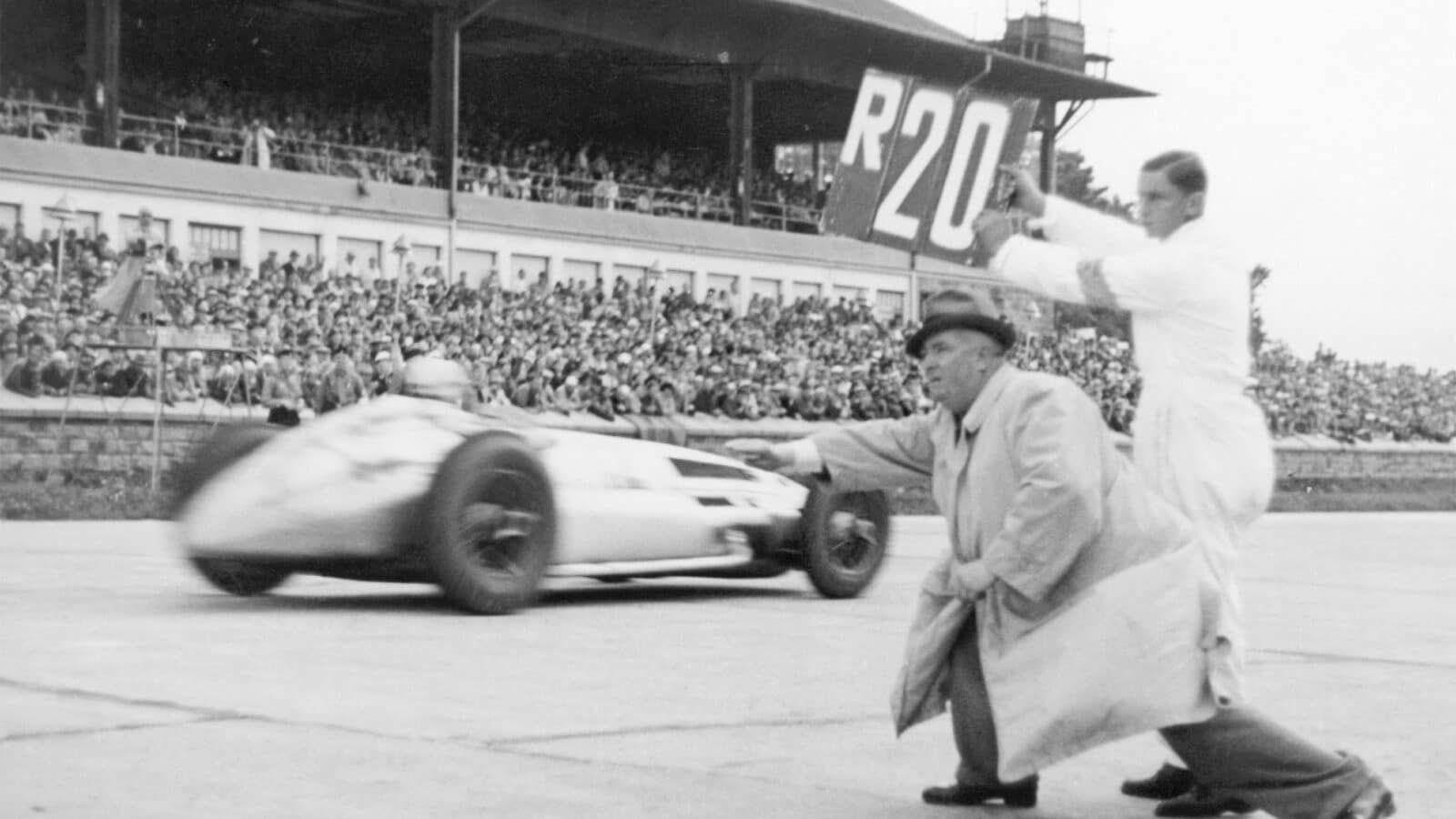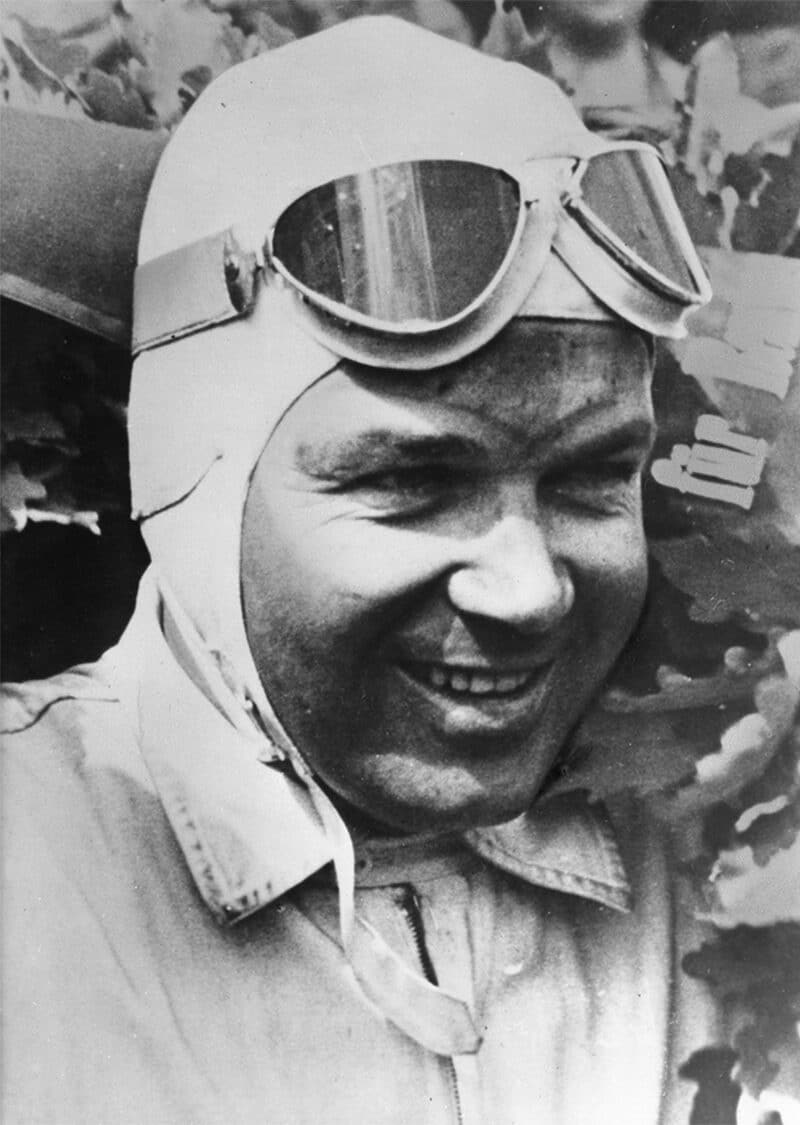During the actual race, however, these speeds were not reached, and Caracciola’s winning average of 75.14mph was the lowest on record since the modern formula cars began in 1934. Caracciola himself made the fastest lap at 81.65mph, and the official record thus remains in the hands of Lang, who set up a speed of exactly 86 mph during the recent Eifel races, and averaged 84.14 mph for ten laps.
Fast practice laps by Lang (9 min 43.1sec), Von Brauchitsch (9 min 51sec), and Caracciola (9 min 56 sec) had given the three Mercedes aces the front positions on the starting grid.
The best Auto-Union lap had been 9 min 59.3 sec by Muller, for Nuvolari had been handicapped through his car catching fire during practice, and it was only just repaired in time.
The skies were dull and threatening when the maroon went off, and the seventeen cars were let loose. Besides the five Auto-Unions and the four Mercedes, there were three Delahayes, Sommer‘s Alfa-Romeo, two of the 3-litre Maseratis, and two 1-litre Maseratis. Lang and Von Brauchitoch shot away in the lead, while both Caracciola and Nuvolari made a slow start. The long procession of white, red, and blue cars snaked off into the hills, and the crowd, not quite so large as usual, settled down to await news from the announcers dotted round the course. At the Karussell hairpin the order was Lang, von Brauchitsch, Muller, Caracciola, and Pietsch, with one of the 3-litre Maseratis. When they reached the grandstand at the end of the first lap, Lang was out on his own, with a lead of 27sec having averaged 79.92mph from a standing start. As the others drove by, there was a murmur of surprise, for Pietsch was now fourth, having passed Caracciola, and Nuvolari had picked up to sixth place. On the next lap came a series of sensations, bringing gasp after gasp from the crowd. Lang was signalled first, as expected, on the indicator board giving the order of cars approaching along the straight, but as he appeared he was slowing for his pit, and a red car was close behind, about to flash by and take the lead! It was Pietsch in his Maserati, showing a terrific turn of speed.
“Neubauer roared down the telephone that he could walk back”
No von Brauchitsch! It was Nuvolari who came next, having passed Caracciola. At last the missing Mercedes appeared, and von Brauchitsch joined Lang at the pits. Plugs were changed on both cars, and they got away, fallen from their proud position. Nuvolari and Caracciola had been close behind Pietsch, the former, indeed, shaking his fist as he tried to pass. Before the Karussell Nuvolari had taken the lead, but Caracciola had fallen back a little and Miller had passed him. Pietsch’s car was beginning to feel the effects of his great dash, and at the end of the third lap he was fourth, behind Nuvolari, Muller, and “Caratsch.” Meanwhile, the other 3-litre Maserati, driven by Villoresi, was stopping almost every lap at its pit, while Stuck retired with a broken petrol pipe, and was brought into the pits seated on the tail of Sommer’s Alfa-Romeo, which was misfiring badly, and also retired.
Worse still, Lang came in again to his pit. His carburetter setting was hopelessly amiss, and as it would take half an hour to alter it, he withdrew. Last place in the Mercedes team had been given to Brendel, the young cadet driver, and on the third lap he showed his paces by averaging no less than 81.10mph, which for a long time stood as the fastest lap of the race. This effort had brought him up to fifth place, but, as the rain was beginning, and the experienced Lang was now idle in the pits, Neubauer, the Mercedes team manager, signalled to him to come in for Lang to take over. Brendel, elated at having passed Muller on the fourth lap, tore by the stands and failed to come in, despite further signals. Then a few minutes later, the speakers announced that Brendel was in the ditch at the Wehrseifer S-bend, and was unable to continue! Lang threw down the seat-cushion which he had been holding in readiness, Neubauer threw down his famous flag, and there was consternation in the Mercedes pits.
A little later Brendel telephoned innocently asking for a car to fetch him back. This was the last straw. Seizing the telephone, Neubauer roared down it that he could—well walk back. Caracciola, at any rate, was moving up, and on the sixth lap took the lead when Nuvolari made a momentary stop at his pit. Von Brauchitsch, however, came in also, and though the wheels were changed and the car refilled, it was decided to withdraw it, because the auxiliary fuel tank was leaking onto the magneto, and there was risk of fire.


